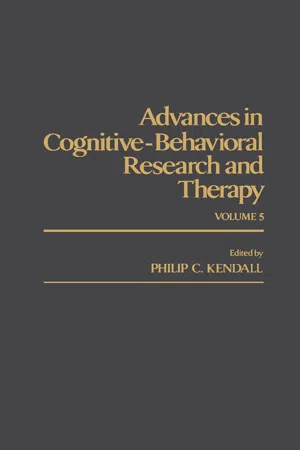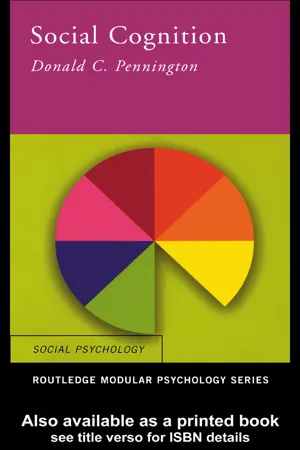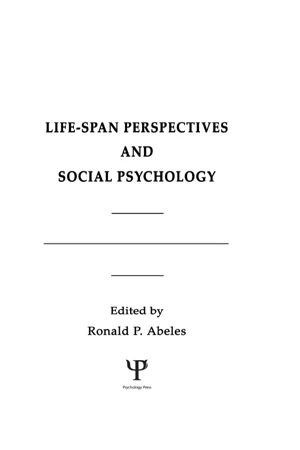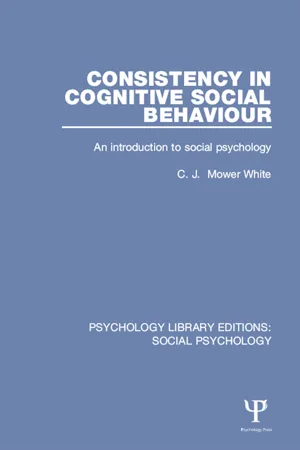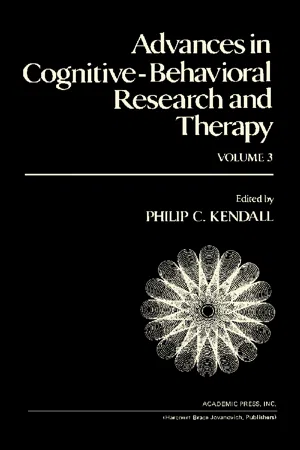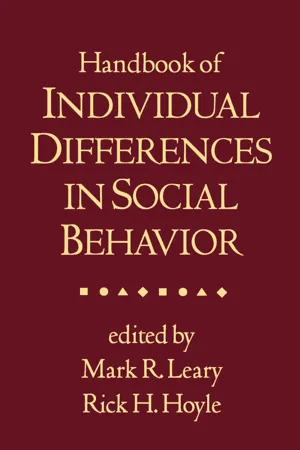Psychology
Attributions
Attributions refer to the explanations people give for the causes of events, behaviors, and outcomes. These explanations can be internal (attributing the cause to personal traits or characteristics) or external (attributing the cause to situational factors). Attributions play a significant role in understanding how individuals perceive and interpret the world around them, influencing their emotions and behaviors.
Written by Perlego with AI-assistance
Related key terms
1 of 5
11 Key excerpts on "Attributions"
- eBook - PDF
- Philip C. Kendall(Author)
- 2013(Publication Date)
- Academic Press(Publisher)
These inferences require the acquisition and processing of information about possible causal fac-tors and about the event or state that has been caused (Kelley, 1967, 1972a). Attribution also refers to the inference of whether a person possesses traits or dispositions to act in particular ways (Jones & Davis, 1965), which is especially relevant to interpersonal situations. For ex-ample, a person who has been helped unexpectedly by another may consider whether the other person's action derived from a disposition to be helpful or from the other's desire to obtain a favor in return. 1 Attribu-1 Attribution has become such a popular term among psychologists that it is sometimes used interchangeably with cognition—even though many cognitions are not Attributions in either of the senses described above. In accord both with theorists' and dictionaries' Causal Attributions in Health and Illness 181 tion research has been reviewed in detail elsewhere (e.g., Harvey & Weary, 1984; Kelley & Michela, 1980; Schneider, Hastorf, & Ellsworth, 1979), so our purpose in this section is to introduce concepts relevant to our subsequent review of Attributions in health. A. Why Study Attributions? 1. The CentraJity of Attributions in Understanding the World Attribution is a powerful theoretical construct within contemporary cognitive analyses of human experience and behavior. These analyses hold that people use their understanding of the world to interpret new information and to make decisions about action. Often a causal analysis is critical to this understanding, because it can provide a succinct repre-sentation of the information necessary for interpretations or decisions. As a simple example, a person may infer that a particular food causes indigestion. This attribution encapsulates, from a potentially vast set of information about foods and one's own body, that the particular food produces a particular effect on the body. - eBook - ePub
- Donald C. Pennington(Author)
- 2012(Publication Date)
- Routledge(Publisher)
2 Attribution of causality I: concepts and theories What are Attributions? The basics Theories of attribution Individual differences Cultural differences Evaluation of concepts and models Summary What are Attributions? Imagine that you have just read about a case in the newspaper where a woman had been convicted of the manslaughter of her husband and yet had been given just a suspended sentence. The woman had suffered years of abuse from her husband and was not able to put up with it any longer; this resulted in her stabbing him to death. Why did she kill her husband? Your best friend, you have recently discovered, has lied to you about her whereabouts last Saturday night. For months both of you had planned to go to a concert and had reserved tickets at the theatre. On the Friday night your best friend rang to say that she could not go out with you because she had to stay in to babysit for her parents. In fact she went out to the nightclub with other friends. Why did your friend behave like this towards you? You have just taken a mock psychology examination and been told by your teacher that you have not done very well. This surprises you since you had been revising for weeks for the examination. How do you explain your poor performance? Each of these three examples requires an explanation of someone’s behaviour. In doing this you may infer or make a judgement about the cause of the behaviour. Causal Attributions help us to understand our own and other people’s behaviour. People have a very strong tendency to provide a causal explanation for virtually any act or behaviour —quite often this is achieved with little conscious thought. Heider (1958) initiated the development of the attribution approach in social psychology. He proposed that the main reason people make causal explanations is to help them predict and control their social worlds - eBook - ePub
- Jane Callaghan, Lisa Lazard(Authors)
- 2011(Publication Date)
- Learning Matters(Publisher)
Chapter 2 AttributionsLearning outcomes
By the end of this chapter you should:– have an understanding of classic theories of attribution and attributional processes, which seek to understand how we explain and make sense of our everyday lives;– be able to apply the concept of attribution theory to real-life examples;– understand some of the limitations of attribution theory, particularly in relation to its mechanistic and individualist terms of reference;– be able to demonstrate an understanding of how we form our everyday explanations of our social world within a complex social context, and understand that such Attributions are not just cognitive phenomena in the way that many mainstream social psychological accounts suggest but that they are also socially constituted phenomena;– be aware of concerns about applying abstract theory to important real-life issues (such as criminality);– have had an opportunity to develop your oral communication skills by delivering a presentation, and have developed your critical thinking skills.Introduction
Much of our everyday life is devoted to figuring out why things happen in our social world. Human beings are motivated by a desire to understand, and our understandings of our social experiences are often framed in terms of why questions: Why did that happen? Why did you do that? Why now? Why me? In other words, people can be understood as continually looking for, proposing and explaining the causes of behaviour (their own as well as others’), experiences and phenomena in general. The everyday causal explanations we give to events and actions in our world are described in social psychological theory as Attributions. Attribution theory is generally concerned with explaining and exploring the processes we use to attribute different kinds of causes to particular behaviours and events. In this chapter, we will explore attribution theorists’ attempts to explain why it is that people in general need to know why - Brendan Gough(Author)
- 2017(Publication Date)
- Palgrave Macmillan(Publisher)
People commonly therefore attribute to others characteristics that allow for inferences that those people will act in particular ways, leading to certain outcomes. Attribution, therefore, is a core part of how we in everyday life make sense of the social world. The study of attitudes and Attributions, then, potentially offers a wealth of information about how we all make sense of the world in which we live through our evaluations of all that is around us and our explanations of social events and the actions of others. It is unsurprising that social psychologists have for long viewed attitudes and Attributions as offering fertile ground for research. Yet, the very importance and centrality of attitudes and Attributions has led to wide divergences between mainstream and critical social psycholo- gists as to how they should be understood, what they tell us about individuals, and how they relate to the social world. It is these issues that we take up below. C. McVittie and A. McKinlay 271 Mainstream Approaches to Attitudes and Attributions Attitudes and Problems For mainstream approaches, much of the appeal of attitudes stemmed from two particular features. First, attitudes were considered to represent essen- tial parts of the individual: when people stated their attitudes towards target descriptions of others or of social phenomena, they were taken to be revealing deep-rooted and consistent aspects of their inner selves. Thus, the study of people’s attitudes offered a way of finding out what they really felt about ele- ments of their social worlds. Furthermore, given the fundamental nature of attitudes, it was expected that these could usefully predict how people would behave across a range of social situations. Second, and relatedly, the process of discovering the attitudes that people held was regarded as relatively straight- forward.- eBook - ePub
- R. P. Abeles(Author)
- 2014(Publication Date)
- Psychology Press(Publisher)
At this point the reader may feel he or she is being led down a primrose path to nowhere. What, indeed, can we investigate if we do not even have a success, a failure, an objectively definable good or bad event with which to begin? Like you, I am reluctant to follow a path that is a seeming dead end for research and application of social psychological knowledge—that Attributions are individually constructed as one builds a case for the outcome, using a variety of raw materials thrown together in an idiosyncratic shifting manner and that nothing, including the outcome, is a given. However, I see this dilemma at the core of what Heider and other intellectual ancestors were trying to do, and I see this concept of lay attribution, a context devoid of pretensions about “real” causes or even “real” outcomes, as a way to bring that earlier work to greater fruition. Through this morass of radical phenomenology I see a fourth focal area of life-span input to attribution theory and research.The paradox at the core of attribution is as follows. Attributions are not just explanations or answers to an objectively agreed-on set of questions, nor are they reactions to an outcome. They are constructed at the moment and for the moment; they are fluid and dynamic. They are certainly part of a system of self-presentation and personal development, a system that is never completed or static. The individual who attributes or explains is not just explaining; he or she is doing something much more dramatic—constructing the meaning of an outcome, in fact, constructing the outcome itself. Attributions are expressions of motives, such that one is building the outcome so that one may be able to use a certain explanation for it (or, if cornered into a particular explanation that is not satisfactory, changing the status of the outcome). In this sense, Attributions are a phantom, a creation of the moment, and it becomes difficult to see how one can study them, classify them, and use them to understand individuals or events.And yet, only if Attributions are stable, if they have meanings that are both consensually validated and consistent over time, are they going to be useful in the task of creating a “proper” self (or other). To be as useful as they appear to be in society, they must fit dimensions and designate an external, objectifiable reality. The words of attribution must mean something from moment to moment, situation to situation, and person to person. In other words, they must be relatively unambiguous and explainable. They must describe causes - eBook - ePub
Consistency in Cognitive Social Behaviour
An introduction to social psychology
- C.J. Mower White(Author)
- 2015(Publication Date)
- Psychology Press(Publisher)
In discussing attribution theory, this chapter will first consider the basic statements relating to the topic, made by various psychologists (e.g. Heider, 1958; Jones and Davis, 1965; Kelley, 1967). The major concern here has been the conditions under which the cause of behaviour is thought to be the person – his ability, personality, or effort – or else the situation he is in. This concern is echoed throughout attribution theory, as will be seen in the following section: that on self Attributions. The idea that we need to attribute our own behaviour (i.e. to explain to ourselves why we did what we did), rather than having immediate knowledge of our feelings, characteristics and attitudes can be a little disturbing; nevertheless, if one believes this aspect of attribution theory, then it can throw some intriguing light on one’s behaviour. One of the ways in which this aspect of social psychology has attempted to be concerned with applied fields is in the attribution of success and failure. It is apparent that how one attributes the cause of successful behaviour – whether to oneself or to the situation in which it occurred – may markedly affect similar future behaviour. In the same way the attribution of another person’s successes or failures to himself, or to luck, or to environmental causes may affect his future behaviour. This has been introduced into both clinical and educational fields with some advantage, as will be discussed later in the chapter.A final aspect of attribution which will be considered is relevant to all earlier discussions. It appears that an attribution, once made, is seldom abandoned or changed. This so-called ‘primacy effect’ and its implications will be outlined at the end of the chapter. In conclusion, there will be a consideration of the functions of attribution, in terms of evaluation and consistency, and an analogy will be drawn between a layman’s Attributions and those of the professional psychologist.2 Basic statements in attribution theoryThe major concern in attribution theory has been the conditions under which behaviour is attributed to the person as opposed to the situation in which he behaves. The early work introducing this topic was by Heider (1944, 1958) who claimed that people attempt to see the social environment as predictable and therefore controllable. In order to predict the behaviour of another, we look for the conditions which will explain it, such as his ability or his assumed personality, which Heider termed ‘personal causes’ (1958, p.16). Alternatively his behaviour may be attributed to ‘impersonal causes’ such as a different person, or some non-personal event. If behaviour is seen as being controlled by these external or impersonal causes, then Attributions in terms of personality traits are less likely to be made. We would be unlikely to describe somebody as ‘opinionated’ if we observe him in a debating chamber, particularly if we know that outside the debate he holds opposite views. His behaviour is more likely to be ascribed to the situation he is in. Heider (1958) claims that the effect of the situation is very rarely fully considered by the layman as the cause of behaviour, because we are biased towards making personal Attributions. It is interesting that a similar claim has been made by Mischel (1968) with respect to the way personality theorists have considered the causes of behaviour suggesting that both laymen and psychologists alike have some bias towards making personal Attributions. - eBook - PDF
- Philip C. Kendall(Author)
- 2013(Publication Date)
- Academic Press(Publisher)
There is by now considerable support for the concept that observers will move from dispositional or internal Attributions to situa-tionally based or external Attributions if aspects of the environment can be made more salient (Galper, 1976; Reagan & Totten, 1975; Storms, 1973). D. Attributional Categories Utilized by Actors and Observers Much of the early research on attribution theory investigated attribu-tional categories employed by subjects for behavior originating in a stranger. The result has been an interesting array of attributional di-mensions which may be used by individuals in explaining the causes of their own and others' behavior. Kelley (1967) has asserted that causality is typically assigned either to factors within the actor, in the person who is the object of the actor's behavior, or in the circumstances in which the action occurs. The distinction between causes attributable to something within the actor on the one hand and to aspects of the external environment on the other hand was initially popularized by Attributions in Marital Therapy 13 Jones and Davis (1965). Weiner's research (Weiner, Frieze, Kulka, Reed, Rest, & Rosenbaum, 1972) on causal Attributions for success and failure also presents evidence for an internal/external, as well as a sta-ble/unstable dimension. While there has been considerable argument regarding the logic, semantics, and naivete of an internal vs external dimension (Hamilton, 1980; Kruglanski, 1975; Locke & Pennington, 1982; Ross, 1977), the dimension has a powerful intuitive appeal. Moreover, there is considerable evidence that people are generally biased toward internal Attributions as causal explanations for behavior. Jones and Nisbett (1972) hypothesized that people tend to attribute their own behavior to external or situational factors, whereas they tend to attribute the behavior of others to dispositional or internal factors. - No longer available |Learn more
- (Author)
- 2014(Publication Date)
- The English Press(Publisher)
________________________ WORLD TECHNOLOGIES ________________________ Chapter-6 Social Psychology Theories a) Attribution Theory Attribution theory is a social psychology theory developed by Fritz Heider, Harold Kelley, Edward E. Jones, Lee Ross, and Bernard Weiner. The theory explores how individuals attribute causes to events and behavior. Elements of Attribution Theory Developed by Bernard Weiner 1. Locus - location of the cause—internal (dispositional) or external (situational) to the person • Closely related to feelings of self-esteem • If success or failure is attributed to internal factors, success will lead to pride and increased motivation, whereas failure will diminish self-esteem 2. Stability - whether the cause is likely to stay the same in the near future or can change • Closely related to expectations about the future • If students attribute their failure to stable factors such as the difficulty of the subject, they will expect to fail in that subject in the future 3. Controllability - whether the person can control the cause • Related to ambitions such as anger, pity, gratitude, or shame • If we feel responsible for our failures, we may feel guilt • If we feel responsible for our successes, we may feel proud • Failing at a task we cannot control can lead to shame or anger ________________________ WORLD TECHNOLOGIES ________________________ Covariation Theory Developed by Harold Kelley examines how people decide whether an internal or an external attribution will be made. The theory divides the way people attribute causes into two types. • External or situational attribution assigns causality to an outside factor , such as the weather. • Internal or dispositional attribution assigns causality to factors within the person , such as their own level of intelligence or other variables that make the individual responsible for the event. The covariation model has been developed by H. H. Kelley. - No longer available |Learn more
- Philip Banyard, Christine Norman, Gayle Dillon, Belinda Winder, Philip Banyard, Christine Norman, Gayle Dillon, Belinda Winder(Authors)
- 2019(Publication Date)
- SAGE Publications Ltd(Publisher)
How would you explain this impressive feat? Would you Attribution The process of giving reasons for why things happen. Attitudes The preferences and opinions you have about other things, people and concepts in the world. Prosocial behaviour The act of helping out another person, whether as a helping behaviour or as an act of altruism. SOCIAL JUDGEMENTS AND BEHAVIOUR 391 put it down to luck or ability? And what if you knew the teams were local amateurs? Or if they were Premier League teams with international superstars? How would that affect your decision? What you are trying to do is attribute the cause of the goal to a disposition (an internal factor, such as a personality trait or, in this case, individual skill), or the situation (external or circumstantial factors, in this case, luck). Most people would attribute such an impres- sive goal to a player’s disposition (skill) if it was a Premiership club, and to the situation (luck) if it was an amateur player. But why is that? We will look at a number of theories that try to explain the attribution process. 16.2.1 Theories and models of attribution The pioneer of attribution theory, Fritz Heider (1958), suggested that when we try to explain everyday events we rarely do so by random guesswork. Instead, we act like naïve scientists and rationally examine possible dispositional and situational explanations. For instance, when considering the football example, we would think about the intention and ability of the player, as well as anything in the environment that would have made the task easier or more difficult (maybe none of the defenders was paying attention and the goal keeper had left their post). But despite our rational analysis, Heider suggested that we pre- fer stable explanations and are therefore more likely to make dispositional Attributions (i.e. explain events in terms of the individual involved rather than the situation). - Mark R. Leary, Rick H. Hoyle, Mark R. Leary, Rick H. Hoyle(Authors)
- 2013(Publication Date)
- The Guilford Press(Publisher)
Attributional-style research using these measures has shown the utility of the con- struct in many domains, including achieve- ment, education, sport, and work, as well as in areas of therapy and training. Sometimes the research was stimulated by early research- ers showing the relevance of attribution style to a particular type of behavior in a particu- lar context. This is usually followed by the development of context-specific measures. Classic attribution style relies on three fundamental dimensions. The internal– external dimension is essentially identical to the well-established locus-of-control dimen- sion covered earlier. The second dimension is stable–unstable, referring to how change- able or malleable a cause was perceived to be. For example, lack of ability and physical size are relatively stable causes, whereas mood and education are less so. Luck, change, and fate are usually viewed as unstable causes, although they can also be regarded as stable in some instances (e.g., I am an unlucky per- son). The third dimension is global-specific, which involves how pervasive the effect of a cause is. Some perceived causes, such as an inability to communicate, may have wide- spread global consequences, whereas being color blind has much less overall effect. Ac- cording to this system every attribution or explanation for an event can be categorized as shown in Figure 18.1. 18. Locus of Control and Attribution Style 281 Although people’s Attributions for a par- ticular event are influenced by many factors, people tend to have a habitual pattern or style of attribution. The initial system sug- gested that there is an optimally healthy and adaptive versus unhealthy and maladaptive style.- eBook - PDF
Understanding Agency
Social Theory and Responsible Action
- Barry Barnes(Author)
- 1999(Publication Date)
- SAGE Publications Ltd(Publisher)
Attributions of this kind are hard to evaluate because they cite invisible states or powers, but instead of seeking to evaluate them, it is possible to treat them as empir ical phenomena and to make them the subject of scientific curiosity. Thus, in psychology, attribution theorists have studied how far actions are attributed to inner states and how far to external causes. They have treated this as an empirical problem to be invest igated by experiment and observation.2 Although attribution theorists have stressed the impressively compe-tent, even the scientific character, of the behaviour of their experimental subjects, they also claim to have identified many systematic forms of bias in it. Let us look at this attribution bias first. In one experiment, on male subjects, Thibaut and Riecken (1955) created a situation wherein an ind i-vidual (the subject of the experiment, X) requested another ind ividual (Y) to perform a simple task. Y, an actor complicit with the experimenter, invariably performed the task as requested . The only variable in the A BRIEF DIGRESSION ON ATTRIBUTION 35 experiment, as it was repeated with a series of subjects, was the appar-ent social status of Y. Sometimes Y was introduced to X as a powerful ind ividual of high social statu s; at other times Y was introduced as of low status. Later, X was asked if the compliance of Y was the result of external pressure or of the fact that Y was a 'nice guy' who just wanted to be helpful. The finding was that when Y was perceived as of high social status his compliance was overwhelmingly attributed to helpful-ness and 'just wanting to'; whereas, when Y was perceived as of low status, attribution of compliance to external pressure was much more common.
Index pages curate the most relevant extracts from our library of academic textbooks. They’ve been created using an in-house natural language model (NLM), each adding context and meaning to key research topics.
